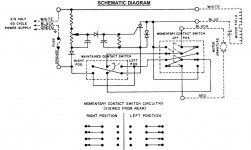simonstjames
Plastic
- Joined
- Feb 3, 2020
- Location
- LA
Hello,
First post and hoping for help.
I have a Rockwell Delta Vertical Knee Mill 21-100. I purchased it not too long ago as it was the right size for me and just got around to really putting it to use. It has a the Variable Power Feed. The feed has worked in the past, rapid feed/movement is fine, but the potentiometer and speed adjustment has been spotty and finally gave out giving me no speed adjustment whatsoever.
I took out the circuitry trying to find some info to get replacement potentiometer. Tracked it down to be a Mallory potentiometer with marking 'M1MPK V13' on the back, nothing else. After more searching I found a catalog which said M1MPK is a 1kohm 4watt.
Ordered a clarostat 1k 4watt replacement which didn't work.
I tracked down manuals on manuals about the RD 21-100 and the powerfeed. I can't find anything as to what the exact specs for the potentiometer were even on the replacement parts list.
So I ask for your help. Is my information correct? Does anyone have the exact specs on the power feed and the potentiometer needed? Is there a newer/more efficient part to use? Can I refurbish the potentiometer? Circuitry is not my forte. Pictures attached, any help is appreciated.
Thanks.
I diassembled the motor (mostly to adjust the mounts and
First post and hoping for help.
I have a Rockwell Delta Vertical Knee Mill 21-100. I purchased it not too long ago as it was the right size for me and just got around to really putting it to use. It has a the Variable Power Feed. The feed has worked in the past, rapid feed/movement is fine, but the potentiometer and speed adjustment has been spotty and finally gave out giving me no speed adjustment whatsoever.
I took out the circuitry trying to find some info to get replacement potentiometer. Tracked it down to be a Mallory potentiometer with marking 'M1MPK V13' on the back, nothing else. After more searching I found a catalog which said M1MPK is a 1kohm 4watt.
Ordered a clarostat 1k 4watt replacement which didn't work.
I tracked down manuals on manuals about the RD 21-100 and the powerfeed. I can't find anything as to what the exact specs for the potentiometer were even on the replacement parts list.
So I ask for your help. Is my information correct? Does anyone have the exact specs on the power feed and the potentiometer needed? Is there a newer/more efficient part to use? Can I refurbish the potentiometer? Circuitry is not my forte. Pictures attached, any help is appreciated.
Thanks.
I diassembled the motor (mostly to adjust the mounts and






